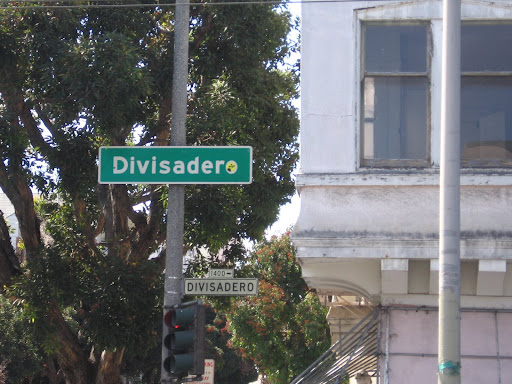
Since I am renting a sublet a block and a half from Divisadero Street in San Francisco, I decided I should read Michael Ondaatje's latest novel, titled Divisadero. As one of the characters explains, the name of the street might mean "division," or it might come from the Spanish verb "divisar," meaning "to gaze at from a distance." Not a bad title, considering that Ondaatje here writes about divided families and about examining the past.
Other than this, Divisadero doesn't illuminate anything about what it means to live in my new neighborhood--most of the action takes place in Napa Valley, in Nevada, or in France. I wouldn't have minded that, though, if Divisadero had illuminated anything about anything else. Instead, I found it a frustrating reading experience. I knew from the start that the book lacks a conventional narrative, but that's not what bothered me. I agree with the New Yorker review that "The sacrifice of plot is tolerable [...] What is damaging is the sacrifice of character. [Ondaatje's] characters are ciphers. We have no affective connection with them. Their stories are too spare, and most of them are impossibly wan figures who seem to be floating outside of time."
Divisadero bothered me not so much for what is in the novel, but for the parts of life that it leaves out. For instance, Ondaatje's world has no place in it for people with a sense of humor. Or for chatty people (characters in Ondaatje novels tend to speak in oblique pronouncements), or for mildly neurotic folks (his characters have Deep Wounds) or for people who aren't as well-read and romantic as himself. Ondaatje's heroes all have exquisitely nuanced appreciations of art and reverently quote from literature. (His villains, naturally, are Philistines.) And these sorts of characters appear in the unlikeliest places. When Anna, a teenage girl, runs away and gets picked up by a truck driver, he is an Ondaatje truck driver, a sensitive and sympathetic fellow who quotes Charles Dickens and takes Anna to visit "the beautiful pastel-painted houses" of a California ghost town. Later, an adult Anna has an affair with a French Gypsy guitarist who carries basil and cilantro in his pockets. Ooh, exoticism much?
I've already alluded to the fact that you shouldn't read Divisadero for its plot. The first 150 or so pages skip around in time to tell the stories of Anna, Claire, and Coop, three people who were raised as siblings on a Northern California farm but who became estranged following an incident of passion and violence. Then, for the last 100 pages, Ondaatje abandons these characters to recount the life story of Lucien Segura, a French writer whom Anna is researching. What's annoying is that when events do happen in Divisadero, they are often implausible. Though Anna runs away from home at 16, and changes her name to ensure that her father could never find her, she somehow manages to become a professor of French literature at Berkeley. In our modern world of SAT tests and academic bureaucracy, is that even possible? Coop, meanwhile, becomes a cardsharp, in scenes that owe more to Hollywood B-movies than to any semblance of reality.
 Although this doesn't seem to be the typical reaction, I actually preferred the Segura section to the Anna/Claire/Coop story. It meanders less and quotes less, and I found some scenes of it more moving. But I also think that Ondaatje's style is naturally suited to writing about the past, rather than the modern world. It's easier to accept his romanticization of "gypsies, tramps and thieves" when these characters lived 100 years ago instead of the present day. Easier to accept his propensity to write about nature when he's describing an era in which people were more closely tied to the land. Easier to accept his narratorial pseudo-profundities, even, when they do not describe characters who belong to our century. Meanwhile, his poet's heart seems unable to deal with modern quotidian reality; it's jarring when he mentions skateboards and hair-dryers.
Although this doesn't seem to be the typical reaction, I actually preferred the Segura section to the Anna/Claire/Coop story. It meanders less and quotes less, and I found some scenes of it more moving. But I also think that Ondaatje's style is naturally suited to writing about the past, rather than the modern world. It's easier to accept his romanticization of "gypsies, tramps and thieves" when these characters lived 100 years ago instead of the present day. Easier to accept his propensity to write about nature when he's describing an era in which people were more closely tied to the land. Easier to accept his narratorial pseudo-profundities, even, when they do not describe characters who belong to our century. Meanwhile, his poet's heart seems unable to deal with modern quotidian reality; it's jarring when he mentions skateboards and hair-dryers.But of course the hair-dryer that Claire uses in 2003 is supposed to parallel Lucien Segura's friend Marie-Neige drying his hair with her shirt 100 years earlier. Divisadero is full of such patterns and repetitions; just about every incident and character has a parallel or two buried elsewhere within the novel. Though Ondaatje's prose is seemingly abstract and meandering, a lot of thought obviously went into the construction of this book. But what is it all supposed to mean, that in two different eras characters get injured by shards of glass and have passionate sex and ride horses in the countryside? History repeats itself in Divisadero, but neither as tragedy nor as farce--so what is Ondaatje trying to say, other than that he really likes certain themes and motifs?
Further reading: This is the funniest and most thoughtful negative review of Divisadero I have found--from the London Review of Books.
No comments:
Post a Comment